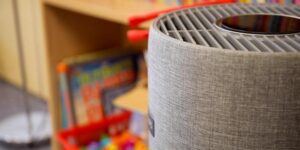Researchers at the University of Leeds are involved in a major scientific investigation into the effectiveness of two types of air cleaning technologies in schools.
Professor Cath Noakes, from Leeds’ School of Civil Engineering, said: ‘Air cleaning technologies are not the silver bullet to controlling infection: they can add to ventilation, but they can’t replace it. So, one issue for schools to think about is – is it better to try and invest in improving ventilation or to add air-cleaning devices?
‘Of course, some schools will struggle to improve ventilation without substantial investment, and then air cleaning technology is likely to be a good choice. But careful thought needs to go into how the system is configured so it is most effective.’
Although the results of this study will not be known until later in the year the researchers have compiled a list of advice to school leaders:
Try to improve ventilation first
Carbon dioxide monitors can identify spaces where ventilation is poor. A reading regularly over 1,500 parts per million (ppm) when the classroom is occupied calls for additional measures such as air cleaning if the ventilation cannot be improved.
Evaluate whether air cleaning technology is a good investment
Air-cleaning technology can be an important measure against Covid-19 transmission and other infectious viruses. But there may be other benefits too. Air filtration also removes other particles such as soot, pollen, and dust and can help reduce exposure to hay fever allergens and pollutants from traffic that may exacerbate asthma.
Costs and benefits
Devices cost between £100 and £1,500 and vary in quality and effectiveness. Air cleaning might not remove all the viral particles and would not stop the virus from spreading between pupils in close proximity to one another. Investing in improving ventilation might generate bigger returns.

Chose the right equipment
To effectively remove viruses, the system must have high-quality filters that catch particles around 0.5 microns in diameter, where a micron is one-millionth of a metre.
As a rule of thumb, in a typical school classroom with 32 people, a total clean air delivery rate (CADR) of around 720 cubic metres an hour (m3/hr) is usually a good estimate. This is often better provided by two or three smaller units with a CADR of 240 – 360 m3/hr each rather than a single large unit.
Where are the devices going to be located
Portable devices should be positioned away from walls and should not be in a confined position where furniture or curtains could affect the airflow.
Maintenance and running costs
Factor in the cost of replacement filters and determine where these can be purchased from, as well as the frequency with which they need to be replaced. If air cleaning devices are used in more polluted environments, the filters may need to be replaced more frequently.
Schedule filter replacement into the school year
Filter changes can often be done in-house but if you have a larger school with multiple units, it may be more effective to have a maintenance contract with a supplier. Filter changes pose a low risk of the virus being released but are better carried out when children are not in the room.
Provide staff training
It is important to remind staff that they still need to open windows and doors, although probably not as wide or as often. An air filter only removes particles from the air, it does not flush out the carbon dioxide. It is important to ventilate the room even when an air cleaning device is in use.
Complete a health and safety risk assessment
Carry out a risk assessment for using and maintaining the air cleaning devices.
Someone to take responsibility for the units
One person should be designated as a responsible officer for managing the devices. This could be someone from the school estates team, a business/site manager, a technician, or a member of teaching staff.
The full guide is published on the TES magazine website.
Photo Credit – Supplied












